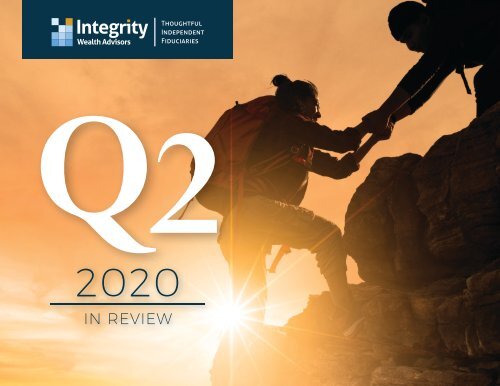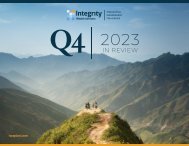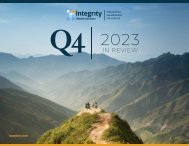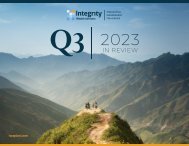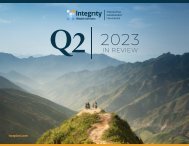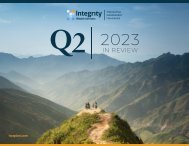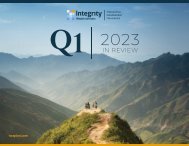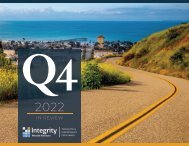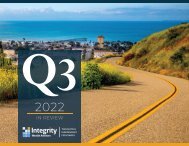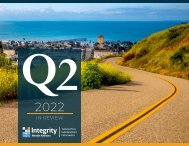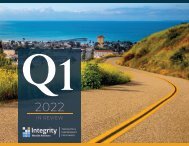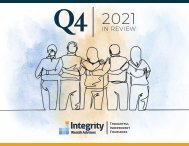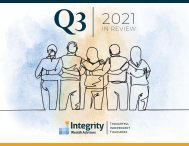2020 Q2 In Review - Integrity Wealth Advisors, Ventura, CA
The National Bureau of Economic Research has officially declared a recession. It’s Business Cycle Dating Committee has confirmed that the expansion that began in June 2009 ended in February 2020. This latest expansion lasted 128 months and was the longest in U.S. history, right behind the previous record of 120 months from March of 1991 to March of 2001. First Quarter GDP contracted by 5%, the largest contraction since the great recession. The overall economic downturn caused by COVID-19 is the sharpest we have seen since the Great Depression, but it also may likely be one of the shortest we have ever seen.... Read more inside.
The National Bureau of Economic Research has officially declared a recession. It’s Business Cycle Dating Committee has confirmed that the expansion that began in June 2009 ended in February 2020. This latest expansion lasted 128 months and was the longest in U.S. history, right behind the previous record of 120 months from March of 1991 to March of 2001. First Quarter GDP contracted by 5%, the largest contraction since the great recession. The overall economic downturn caused by COVID-19 is the sharpest we have seen since the Great Depression, but it also may likely be one of the shortest we have ever seen.... Read more inside.
Create successful ePaper yourself
Turn your PDF publications into a flip-book with our unique Google optimized e-Paper software.
<strong>Q2</strong><br />
<strong>2020</strong><br />
IN REVIEW
TOTAL RETURN <strong>Q2</strong> + NEWSWORTHY EVENTS<br />
April 2 – COVID-19 pandemic:<br />
The number of confirmed<br />
cases of COVID-19 passes 1<br />
million worldwide.<br />
26%<br />
24%<br />
22%<br />
20%<br />
18%<br />
16%<br />
14%<br />
12%<br />
10%<br />
8%<br />
6%<br />
4%<br />
2%<br />
0%<br />
-2%<br />
-4%<br />
April 3 – Nonfarm payrolls<br />
in March fell by 701,000<br />
and the unemployment rate<br />
rose to 4.4%.<br />
S&P 500 TOTAL RETURN<br />
April 20 – Oil prices<br />
reach a record low,<br />
with some West Texas<br />
<strong>In</strong>termediate<br />
contracts falling<br />
into negative values.<br />
May 8 – Worst<br />
jobs report ever, US<br />
economy lost 20.5<br />
million jobs, bringing<br />
the unemployment rate<br />
to 14.7%.<br />
May 26 – The killing of<br />
George Floyd sparked<br />
protests across hundreds<br />
of cities in the United States<br />
and around the world.<br />
May 9 – Several Chinese<br />
and <strong>In</strong>dian soldiers are<br />
injured in a cross-border<br />
clash.<br />
MSCI ACWI EX USA TOTAL RETURN BARCLAYS US AGGREGATE TOTAL RETURN<br />
June 5th – May sees biggest<br />
jobs increase ever of 2.5 million<br />
as economy starts to recover<br />
from coronavirus, unemployment<br />
rate dropped to 13.3%.<br />
June 30 – China<br />
passes the<br />
controversial Hong<br />
Kong national<br />
security law,<br />
allowing China<br />
to crack down<br />
on opposition to<br />
Beijing at home or<br />
abroad.<br />
20.5%<br />
16.3%<br />
2.89%<br />
-6%<br />
April, <strong>2020</strong><br />
May, <strong>2020</strong><br />
June, <strong>2020</strong><br />
12%<br />
S&P 500 TOTAL RETURN<br />
MSCI ACWI EX USA TOTAL RETURN<br />
BARCLAYS US AGGREGATE TOTAL RETURN<br />
As of close 6/30/<strong>2020</strong><br />
11%<br />
10.42%
IT’S OFFICIAL...<br />
<strong>2020</strong><br />
<strong>Q2</strong><br />
IN REVIEW<br />
July 14, <strong>2020</strong><br />
The National Bureau of Economic Research has officially declared a recession. It’s Business Cycle Dating Committee has confirmed that the expansion that<br />
began in June 2009 ended in February <strong>2020</strong>. This latest expansion lasted 128 months and was the longest in U.S. history, right behind the previous record<br />
of 120 months from March of 1991 to March of 2001. First Quarter GDP contracted by 5%, the largest contraction since the great recession. The overall<br />
economic downturn caused by COVID-19 is the sharpest we have seen since the Great Depression, but it also may likely be one of the shortest we have ever<br />
seen.<br />
What about the pick-up in new cases which is causing governments to reverse prior moves to re-open bars and restaurants? On May 31st, 352,947 people<br />
went through TSA airport security checks. On June 22nd, as reports of a surge in new cases started to appear, TSA counted 607,540 passengers. If these<br />
re-closures are slowing activity, we can’t see it in the TSA data. <strong>In</strong> other words, while many seem to think that a surge in new cases and some reversals in<br />
openings will do the same kind of damage to economic activity that we saw in March and April, the data does not show it yet. We put the odds of another<br />
nation-wide economic shutdown very low and we expect economic data to continue to improve in the weeks and months ahead.<br />
ECONOMIC CHARTS & NOTES<br />
CONSUMER SENTIMENT <strong>In</strong> April, consumer sentiment reached its lowest<br />
level in nearly a decade but rebounded in May as relief checks and discounted<br />
prices boosted purchasing attitudes. Retail sales posted their biggest monthly<br />
increase ever in May.<br />
EMPLOYMENT <strong>In</strong> April, the U.S. unemployment rate spiked to 14.7%<br />
before improving to 13.3% in May as the economy began to reopen. Nonfarm<br />
payrolls recorded their largest increase in history rising by 2.5 million in May<br />
as furloughed workers in the hospitality, leisure, and other industries started<br />
to return to work.<br />
3Mo Moving Avg Yr/Yr %<br />
Consumer Sentiment<br />
Unemployment Rate<br />
NonFarm Payroll<br />
6%<br />
100<br />
16%<br />
2200<br />
3Mo Moving Avg Yr/Yr %<br />
4%<br />
2%<br />
0%<br />
-2%<br />
-4%<br />
-6%<br />
95<br />
90<br />
85<br />
80<br />
75<br />
Consumer Sentiment<br />
Unemployment Rate %<br />
14%<br />
12%<br />
10%<br />
8%<br />
6%<br />
4%<br />
-825<br />
-3850<br />
-6875<br />
-9900<br />
-12925<br />
-15950<br />
-18975<br />
Monthly Employment Change<br />
-8%<br />
Jan '17<br />
Jul '17<br />
Jan '18<br />
Jul '18<br />
Jan '19<br />
Jul ' 19<br />
Jan '20<br />
70<br />
2%<br />
Jan ' 16<br />
Jul '16<br />
Jan '17<br />
Jul '17<br />
Jan '18<br />
Jul '18<br />
Jan '19<br />
Jul '19<br />
Jan '20<br />
-22000
ECONOMIC CHARTS & NOTES<br />
WAGES & SALARIES Wages and salaries rose at record rates in the second<br />
quarter reflecting a high portion of job losses from lower paying occupations.<br />
CONSUMER SPENDING U.S. personal income spiked by a record 14% yearover-year<br />
in April due to federal economic recovery programs and increased 8%<br />
in May. Consumer spending rebounced sharply in May as stores and restaurants<br />
began to open their doors.<br />
Earnings (Private) Y/Y % Change<br />
Earnings Y/Y % Change<br />
Consumption<br />
Disposable <strong>In</strong>come<br />
8<br />
15<br />
7<br />
10<br />
Quarterly Year-over-Year<br />
6<br />
5<br />
4<br />
3<br />
2<br />
Year-over-year<br />
5<br />
0<br />
-5<br />
-10<br />
-15<br />
1<br />
'08<br />
'09<br />
'10<br />
'11<br />
'12<br />
'13<br />
'14<br />
'15<br />
'16<br />
'17<br />
'18<br />
'19<br />
'20<br />
-20<br />
Jul '16<br />
Jan '17<br />
Jul '17<br />
Jan '18<br />
Jul '18<br />
Jan '19<br />
Jul '19<br />
Jan '20<br />
JOB OPENINGS & HIRES Retail hiring and job openings slowed considerably<br />
at the start of the second quarter with many non-essential businesses suspending<br />
operations. The employment data improved in May as retailers began to reopen.<br />
CONSUMER PRICE INDEX (CPI) For the first time ever the consumer<br />
price index fell for the third straight month in May amid closures and muted<br />
demand for non-essential goods due to the pandemic-led recession. <strong>In</strong>flation<br />
was also weak excluding food and energy prices.<br />
Retail Openings<br />
Retail Hires<br />
CPI Less Food/Energy<br />
CPI All<br />
1200<br />
3.0<br />
1000<br />
2.5<br />
Amount in Thousands<br />
800<br />
600<br />
400<br />
200<br />
Y/Y %<br />
2.0<br />
1.5<br />
1.0<br />
0.5<br />
0<br />
Jan '18<br />
Jul '18<br />
Jan '19<br />
Jul '19<br />
Jan '20<br />
0.0<br />
Jul '16<br />
Jan '17<br />
Jul '17<br />
Jan '18<br />
Jul '18<br />
Jan '19<br />
Jul '19<br />
Jan '20
LONGER-TERM COVID-19<br />
IMPLI<strong>CA</strong>TIONS...<br />
PEOPLE ARE<br />
STEADILY RETURNING<br />
TO THE SKIES<br />
<strong>2020</strong><br />
<strong>Q2</strong><br />
IN REVIEW<br />
Low<br />
interest rates<br />
for longer<br />
Less<br />
globalization<br />
More<br />
government debt<br />
and bigger share<br />
of government in<br />
the economy<br />
Higher<br />
inflation…<br />
eventually<br />
Pressure<br />
on profit<br />
margins<br />
SOURCE: TSA, U.S. Global <strong>In</strong>vestors. As of June 28<br />
US LEADING INDEX Following a sharp decline in previous months, the<br />
U.S. Leading Economic <strong>In</strong>dex improved in May. This was largely due to lower<br />
unemployment insurance claims as economic activity rebounded.<br />
GDP The U.S. economy contracted 5% in the first quarter due to the onset<br />
of the coronavirus pandemic. A sharp drop in GDP is expected for the second<br />
quarter followed by a healthy rebound in the second half of the year.<br />
Leading <strong>In</strong>dex for the United States<br />
GDP<br />
4%<br />
4%<br />
2%<br />
0%<br />
3%<br />
2%<br />
1%<br />
-2%<br />
-4%<br />
% Growth<br />
0%<br />
-1%<br />
-2%<br />
-6%<br />
-3%<br />
-8%<br />
2015<br />
2016<br />
2017<br />
2018<br />
2019 <strong>2020</strong><br />
-4%<br />
-5%<br />
Q1 Q3 Q4 Q1 <strong>Q2</strong> Q3 Q4 Q1 <strong>Q2</strong> Q3 Q4 Q1 <strong>Q2</strong> Q3 Q4 Q1 <strong>Q2</strong> Q3 Q4 Q1<br />
<strong>Q2</strong><br />
2015<br />
2016<br />
2017<br />
2018 2019 <strong>2020</strong>
INVESTMENT<br />
MANAGEMENT<br />
PHILOSOPHY<br />
The complex, ever-changing investment world of today<br />
requires an investment process that is overseen by a team<br />
of experienced investment professionals. Global capital<br />
markets present investors with a host of challenges due to<br />
the combination of an overwhelming amount of information<br />
to analyze and the endless supply of conflicting opinions and<br />
narratives surrounding financial markets. The time and expertise<br />
required to perform in-depth investment research and to make<br />
timely and informed portfolio management decisions requires<br />
both a clear investment process and an experienced investment<br />
team to implement the process.<br />
An old adage states that there is accomplishment through<br />
many advisors. We agree and embrace a variety of investment<br />
perspectives through our investment committee. Our investment<br />
philosophy is well grounded in global macro-economic analysis.<br />
<strong>In</strong>vestment ideas are carefully vetted through a process which<br />
incorporates the diverse range of investment backgrounds<br />
within our firm. This process of multifaceted analysis ensures<br />
that only the strongest investment ideas survive. We are<br />
committed to striking the right balance between risk and<br />
return through managing global, multi-asset class investment<br />
portfolios.<br />
INDEPENDENCE &<br />
CLIENT FOCUS<br />
DIVERSIFI<strong>CA</strong>TION<br />
TOP-DOWN, THEMATIC<br />
APPROACH<br />
PERFORMANCE WITH<br />
LIQUIDITY<br />
VARIED INVESTMENT<br />
PERSPECTIVES<br />
OPTIMIZATION OF<br />
EXPENSES AND TAXES<br />
ASSESSMENT OF GLOBAL<br />
ECONOMIC & INVESTMENT<br />
ENVIRONMENT<br />
THE INVESTMENT PROCESS<br />
ASSESS & ANALYZE<br />
THEMES<br />
RESEARCH INVESTMENT<br />
VEHICLES TO FIND<br />
EFFECTIVE IMPLEMENTATION<br />
Q3 INVESTMENT<br />
COMMITTEE<br />
GUEST SPEAKER<br />
Andrew Opdyke, CFA – Andrew holds an<br />
MBA from Northwestern University, and a<br />
BA in Business and Economics from Hope<br />
College.<br />
IDENTIFY<br />
OPPORTUNITIES<br />
STRATEGIC ASSET<br />
ALLO<strong>CA</strong>TION -<br />
Geographies, Sectors,<br />
Capitalizations<br />
INVESTMENT SELECTION -<br />
Open/Closed End Funds, ETFs,<br />
Stocks & Bonds<br />
Talley Léger, Senior <strong>In</strong>vestment Strategist<br />
– Talley earned an MS degree in financial<br />
economics from Boston University.
INVESTMENT<br />
COMMITTEE<br />
<strong>2020</strong><br />
<strong>Q2</strong><br />
IN REVIEW<br />
The <strong>In</strong>vestment Committee meets formally each quarter, and more frequently if market conditions<br />
warrant, to discuss the state of the global economy and capital markets and to assess the current<br />
asset allocation and positioning of our portfolios. There’s an art to striking the right balance between risk and return, pursuing<br />
that symmetry is the core of our investment philosophy. We are fiduciaries and have our interests aligned with our clients as<br />
we invest alongside them. Contact us at info@wagnerfinancial.com with any questions or concerns.<br />
STEPHEN WAGNER<br />
<strong>In</strong>vestment Advisor,<br />
CFP ® , CPFA<br />
VICTORIA BREEN<br />
<strong>In</strong>vestment Advisor &<br />
Financial Planner<br />
MARTHA LAFF<br />
<strong>In</strong>vestment Advisor,<br />
ChFC ® , CLU ® , CRPC ®<br />
ANDREW MURTHA<br />
Financial Analyst,<br />
MBA<br />
BOB CHEATHAM<br />
Financial Planner,<br />
CRPS®, MA<br />
35+ Years Experience*<br />
40+ Years Experience*<br />
30+ Years Experience*<br />
20+ Years Experience*<br />
15+ Years Experience*<br />
MARGARET MARAPAO<br />
<strong>In</strong>vestment Advisor,<br />
CFP ®<br />
CHRISTOPHER WAGNER<br />
<strong>In</strong>vestment Advisor,<br />
CPFA<br />
LAINE MILLER<br />
<strong>In</strong>vestment Advisor &<br />
Financial Planner<br />
DOUG ECKER<br />
Retirement Plan<br />
Specialist<br />
GRACE RIVERA<br />
<strong>In</strong>vestment Advisor &<br />
Financial Planner<br />
* Financial services experience. <strong>In</strong>vestment Advisory Services are offered through investment advisor representatives of <strong>In</strong>tegrity <strong>Wealth</strong> <strong>Advisors</strong>, a Federally Registered <strong>In</strong>vestment Advisor.<br />
THOUGHTFUL<br />
INDEPENDENT<br />
FIDUCIARIES<br />
Wagner Financial has been committed to helping individuals, families,<br />
and businesses grow, preserve, and distribute wealth since 1987.<br />
196 S Fir Street, Suite 140, <strong>Ventura</strong>, <strong>CA</strong> 93001<br />
www.wagnerfinancial.com | (805) 339-0760
<strong>2020</strong><br />
<strong>Q2</strong><br />
IN REVIEW<br />
PUTTING THINGS INTO PERSPECTIVE<br />
The M2 measure of money (a measure of the money supply that includes cash, checking deposits, and easily convertible near money) is up 25%<br />
year over year, one of the fastest paces we have ever seen. With this deluge of new money and the improvement in economic data we feel equity<br />
markets should continue to rise.<br />
However, many continue to feel as if the world is falling apart, and we are certainly dealing with many issues that are causing uncertainty.<br />
However, it’s important to remember history. <strong>In</strong> the Civil War, the US lost 620,000 men, 2% of the population, the equivalent of more than 6 million<br />
people today. World War I, World War II and the Spanish Flu were devastating. Yet, in every case, the United States continued to prosper.<br />
Many believe that this time will be different, but we think that humans are resilient and that things will get back to normal. It may not happen<br />
straightaway, but we believe it will happen. Competition between states, businesses and everyday people to grow and enjoy life will push<br />
everyone forward. Just like after 9/11, people will fly again. They already are. They will go to restaurants again, and sporting events and theaters.<br />
But it will take time.<br />
We believe the first few months will initially look like a V recovery, but then things will grow more slowly unless we get a widely distributed<br />
vaccine. We may not see 4% or lower unemployment rates again until late 2022 or 2023, possibly even longer. But day after day, week after week,<br />
month after month, advancement will be made. We remain hopeful. We have history on our side.<br />
Record levels of stimulus, sustained low interest rates and ongoing low inflation create a supportive environment for stock market returns<br />
going forward. We will continue to act in the best interets of our clients, serving as fiduciaries. Please feel free to reach out to any of us with any<br />
questions or concerns.<br />
Warm Regards,<br />
Stephen H. Wagner, CFP ®<br />
<strong>In</strong>vestment Committee Chair<br />
info@wagnerfinancial.com<br />
"We remain hopeful.<br />
We have history on our side."
THE IMPACT OF<br />
SOUND FINANCIAL<br />
PLANNING<br />
Recent Vanguard research 1 shows that an experienced<br />
wealth management team not only adds peace of mind,<br />
but also may add about 3 percentage points of value in<br />
net portfolio returns over time. What does this mean? Your<br />
team has the ability and the time to evaluate your portfolio<br />
investments, meet with you to discuss objectives, and<br />
help get you through tough markets. All of these factored<br />
together potentially add value to your net returns (returns<br />
after taxes and fees) over time. But the most interesting part<br />
of this research is that it shows that financial planning and<br />
financial coaching contributed to the greater majority of the<br />
added net 3% in net portfolio returns.<br />
It’s important to realize how valuable making sound financial<br />
planning decisions are, and the value that is added by your<br />
financial planning team. As investors, our emotions can be<br />
our worst enemy, especially when the markets are volatile,<br />
and guidance from a “behavioral coach” can save us from<br />
panic-selling and abandoning long-term financial plans.<br />
Numerous studies demonstrate that advisors can have a<br />
huge impact on investor finances, but it’s hard to say if these<br />
findings have been recognized and understood by everyday<br />
investors.<br />
VICKI'S VIEW<br />
If you’re facing unemployment or concerned<br />
about the possibility of upcoming layoffs, there<br />
are some small, proactive steps you can take now<br />
to help make this difficult time more manageable.<br />
Build Your Network. It’s estimated that over 80%<br />
of open positions are filled through networking.<br />
The easiest time to build your network is while<br />
you are still employed. Websites like Linked<strong>In</strong> are<br />
a great way to connect with current coworkers<br />
now so you can easily maintain contact in<br />
the future. Look into joining professional<br />
organizations in your field as well. Many of these<br />
organizations offer networking events, online job<br />
postings, and learning opportunities.<br />
Update Your Resume. If you’ve been at the same<br />
job for years, it’s likely that you haven’t updated<br />
your resume in quite some time. Take inventory<br />
of your current job responsibilities as well as<br />
major projects or accomplishments. If you can<br />
quantify your successes with metrics, all the<br />
better! Once you’re done updating your resume,<br />
ask a few people who you know well to review<br />
and provide input on whether you’ve missed<br />
anything.<br />
FACING POSSIBLE UNEMPLOYMENT?<br />
TAKE THESE STEPS TO PREPARE<br />
certain qualification requirements. You may<br />
be able to purchase private insurance through<br />
the Marketplace, or qualify for Medicaid.3 Start<br />
exploring what’s available and what makes the<br />
most sense for your unique situation.<br />
Calculate Your Unemployment Benefits.<br />
Many factors go into unemployment benefit<br />
calculations, including the state you live in, how<br />
long you were employed, and your salary. Do a<br />
quick search online to find out the process for<br />
applying in your state, and how much you can<br />
potentially collect. This way, if you do get laid<br />
off, you will have all the information you need to<br />
submit a claim immediately.<br />
Cut Nonessential Expenses. If you don’t have<br />
an emergency savings account started, now is<br />
the time to start! Do an audit of your monthly<br />
expenses and see where you can cut back. If<br />
you’re not actively using a service but still paying<br />
for it, consider cancelling. If you’re locked into a<br />
contract with your subscription services, weigh<br />
the short-term cost of an early termination fee<br />
versus continuing to pay monthly for a service<br />
you may not be able to afford.<br />
DREAM.<br />
PLAN.<br />
ENJOY.<br />
Understand Your <strong>In</strong>surance Options. If<br />
you’re facing the possibility of losing health<br />
insurance, it’s important to do some research<br />
and understand what your options are. The<br />
Consolidated Omnibus Budget Reconciliation<br />
Act, or COBRA, allows you to continue your group<br />
benefits for a limited amount of time. You’re<br />
responsible for paying out of pocket for this<br />
continuation of coverage, and you must meet<br />
Stay Positive. Facing unemployment can be<br />
extremely stressful. Try to stay optimistic about<br />
your future and the opportunities that await<br />
you. Have you always wanted to try something<br />
new? Is to, this may be a great time to transition<br />
to a new career. If you’re concerned about your<br />
financial situation and want to ensure you’re<br />
prepared for the worst, please reach out. I’m here<br />
to help.
The risks to your wealth aren’t only in the financial markets.<br />
The wealthier you become, the more liability protection matters. We live in a litigious world, one in which even friends<br />
and neighbors can be convinced to see opportunity in the wake of misfortune.<br />
LAINE'S LEDGER<br />
DO YOU HAVE LIABILITY<br />
PROTECTION?<br />
A (larger) umbrella liability policy may be an excellent idea. Could you afford a six-figure drawdown of your personal<br />
assets to settle a lawsuit? Ideally, you have umbrella liability coverage with a limit that equals or exceeds your net<br />
worth. The premiums are reasonable: $1 million of coverage commonly costs $150 to $300 per year, according to<br />
the <strong>In</strong>surance <strong>In</strong>formation <strong>In</strong>stitute. Premiums may then rise only incrementally for larger policies. You may want to<br />
consider both general and professional liability coverage, the latter of which protects a business against damage done<br />
by its services or products. Consider creating an LLC or S corp. If you own rental property, setting up a limited liability<br />
or S corporation can be a wise move. If tenants want to sue for any reason, they will be suing the corporate entity<br />
rather than you. Your other personal assets will be shielded from their claims.<br />
What degree of liability protection do you have now? Many high net worth professionals and business owners are<br />
inadequately covered against “predators and creditors.” This is worth a conversation. Real wealth demands an<br />
advanced asset protection strategy.<br />
CHRIS'S CORNER<br />
BEYOND RETIREMENT:<br />
WHAT ABOUT YOUR<br />
OTHER GOALS?<br />
Let's say that at the age of 25, you earned $35,000.<br />
If your salary increased at the average historical<br />
rate, you'd have earned nearly $2 million in total by<br />
the time you were 65. That might sound like a lot --<br />
until you begin thinking about all the financial goals<br />
you'll need to juggle in a lifetime, including buying<br />
a home and paying for your child's education, while<br />
funding your own retirement.<br />
If managed wisely, your money could potentially<br />
go a long way. It's really all about putting a plan in<br />
place and sticking to it.<br />
These tips may help get you started.<br />
Get a Jump on All Your Goals<br />
You've read in these pages before about the value<br />
of starting early on retirement savings, even if you<br />
can only invest a little each month. The same goes<br />
for college savings and other goals. Even a $100<br />
a month investment for college could potentially<br />
leave you with about $16,470 in 10 years, assuming<br />
an average annual return of 6% -- a good start that<br />
you can build on as your income grows.<br />
Set Aside a Slice of Pay Hikes<br />
As your income rises over the course of your career,<br />
it's easy to slip into a pattern of "living up" to your<br />
means; that is, spending that extra pay you didn't<br />
have before on daily living expenses. <strong>In</strong>stead,<br />
consider setting a quota for yourself: Earmark a<br />
predetermined portion of every pay hike for your<br />
savings goals. You may want to apply the same rule<br />
to other windfalls, like an unexpected bonus or tax<br />
return.<br />
Use the Right Tools for the Job<br />
Just as your employer-sponsored retirement plan<br />
offers a tax-advantaged opportunity to set aside<br />
money for your later years, certain vehicles, such<br />
as 529 college savings plans, provide potentially<br />
attractive tax breaks for college savers. Minimizing<br />
the taxes you have to pay up front on investments<br />
and earnings gives you the chance to make the<br />
most of compounding over time.<br />
Finally, whatever your particular financial goals may<br />
be, keep in mind that minimizing debt is a timeless,<br />
indispensable strategy for establishing personal<br />
financial balance.
MAIN STREET LENDING<br />
PROGRAM DETAILS<br />
As a result of the Coronavirus Aid, Relief & Economic Security (<strong>CA</strong>RES) Act, the Federal Reserve has<br />
created the Main Street Lending Program to provide a total of $600 billion in financing for small and<br />
medium-sized businesses. Here’s what you need to know to check eligibility and get ready to apply.<br />
For more information visit https://www.uschamber.com/report/guide-the-main-street-lending-program<br />
1 AM I ELIGIBLE? 3 HOW MUCH <strong>CA</strong>N I BORROW?<br />
<strong>In</strong> order to be eligible for a Main Street Lending Program loan, a<br />
business must:<br />
• Have been established before March 13, <strong>2020</strong><br />
• Not be an ineligible business according to Small Business<br />
Administration (SBA) regulations<br />
• Have no more than 15,000 employees or 2019 annual revenues of<br />
no more than $5 billion<br />
• The SBA’s affiliation rules apply in determining the employee and<br />
revenue count<br />
• <strong>In</strong> counting employees, the Main Street Lending Program advises<br />
businesses to refer to SBA regulations by counting all full-time,<br />
part-time, seasonal, or otherwise employed persons, excluding<br />
volunteers and independent contractors<br />
• Have been created or organized in the U.S. with significant<br />
operations in and a majority of its employees based in the U.S.<br />
All of the above criteria must be met in order to be eligible.<br />
2<br />
HOW DO I APPLY?<br />
Eligible borrowers must submit an application and other<br />
documentation required by an eligible lender. Borrowers should<br />
contact lenders for more information on whether the lender plans<br />
to participate in the program and for more information on the<br />
application process. Additional information about the application<br />
process will be announced in the future.<br />
Eligible lenders are U.S. federally-insured depository institutions<br />
(including banks, savings associations, and credit unions) as<br />
well as any U.S. branch or affiliate of a foreign bank. Nonbank<br />
financial institutions are not considered eligible lenders at this time,<br />
although the Federal Reserve is considering options to expand this<br />
list in the future.<br />
The Main Street Lending Program offers three different secured or unsecured 5-year<br />
term loan options set at an adjustable rate of LIBOR (1 or 3 month) plus 300 basis<br />
points with principal deferred for two years and interest payments deferred for<br />
one year for eligible borrowers. All loans under the Main Street Lending Program<br />
must permit prepayment without penalty. All loans are made by private financial<br />
institutions but backed by the Federal Reserve.<br />
Term<br />
MAIN STREET LENDING PROGRAM LOAN OPTIONS<br />
Main Street<br />
New Loans<br />
Main Street<br />
Priority Loans<br />
EBITDA: Earnings before interest, tax, depreciation and amortization<br />
LIBOR: London <strong>In</strong>terbank Offer Rate, a common benchmark interest rate index<br />
Main Street<br />
Expanded Loans<br />
Minimum Loan Size $250,000 $250,000 $10,000,000<br />
Maximum Loan Size<br />
Risk Retention<br />
by Lender<br />
Payment (year one<br />
deferred for all)<br />
Lesser of $35M or<br />
4x 2019 adjusted<br />
EBITDA<br />
Lesser of $35M or<br />
6x 2019 adjusted<br />
EBITDA<br />
5% 5% 5%<br />
Years 3-5:<br />
15%, 15%, 70%<br />
Years 3-5:<br />
15%, 15%, 70%<br />
Lesser of $300M, 35% of<br />
outstanding and undrawn<br />
available debt, or 6x 2019<br />
adjusted EBITDA<br />
Years 3-5:<br />
15%, 15%, 70%<br />
Rate LIBOR + 3% LIBOR + 3% LIBOR + 3%<br />
Lender Transaction<br />
Fee (May be paid by<br />
Borrower)<br />
Borrower<br />
Origination Fee<br />
5 years 5 years 5 years<br />
100 basis points of<br />
principal loan amount<br />
100 basis points of<br />
principal loan amount<br />
100 basis points of<br />
principal loan amount<br />
100 basis points of<br />
principal loan amount<br />
75 basis points of<br />
principal loan amount<br />
75 basis points of<br />
principal loan amount
196 S Fir Street, Suite 140, <strong>Ventura</strong>, <strong>CA</strong> 93001<br />
integritywealthadvisors.info | (805) 947-0202<br />
Data / statistics cited are provided by the Federal Reserve Bank of St. Louis.<br />
The S&P 500 <strong>In</strong>dex or the Standard & Poor's 500 <strong>In</strong>dex is a market-capitalization-weighted index of the 500 largest U.S. publicly traded companies. The S&P<br />
500 is a float-weighted index, meaning company market capitalizations are adjusted by the number of shares available for public trading. <strong>In</strong>vestors cannot<br />
invest directly in an index. Note: <strong>In</strong>vestors cannot invest directly in an index. These unmanaged indices do not reflect management fees and transaction<br />
costs that are associated with most investments.<br />
The MSCI World ex USA <strong>In</strong>dex captures large and mid cap representation across 22 of 23 Developed Markets (DM) countries* – excluding the United States.<br />
With 1,012 constituents, the index covers approximately 85% of the free float-adjusted market capitalization in each country.<br />
The Barclays Capital U.S. Aggregate Bond <strong>In</strong>dex is the most common index used to track the performance of investment grade bonds in the U.S.<br />
Vanguard research study; Source: Francis M. Kinniry Jr., Colleen M. Jaconetti, Michael A. DiJoseph, and Yan Zilbering, 2014. Putting a value on your value:<br />
Quantifying Vanguard Advisor’s Alpha. Valley Forge, Pa.: The Vanguard Group.<br />
<strong>In</strong>tegrity <strong>Wealth</strong> <strong>Advisors</strong>, <strong>In</strong>c. is a Registered <strong>In</strong>vestment Adviser. This material is solely for informational purposes. Advisory services are only offered to<br />
clients or prospective clients where <strong>In</strong>tegrity <strong>Wealth</strong> <strong>Advisors</strong>, <strong>In</strong>c. and its representatives are properly licensed or exempt from licensure. <strong>In</strong>vesting involves<br />
risk and possible loss of principal capital. No advice may be rendered by <strong>In</strong>tegrity <strong>Wealth</strong> <strong>Advisors</strong>, <strong>In</strong>c. unless a client service agreement is in place.


